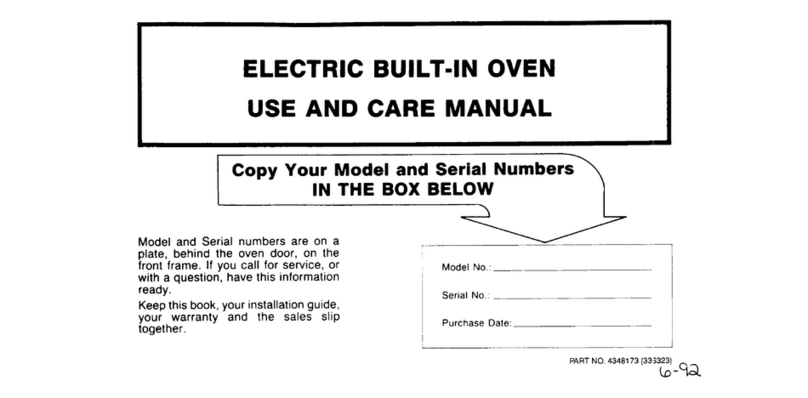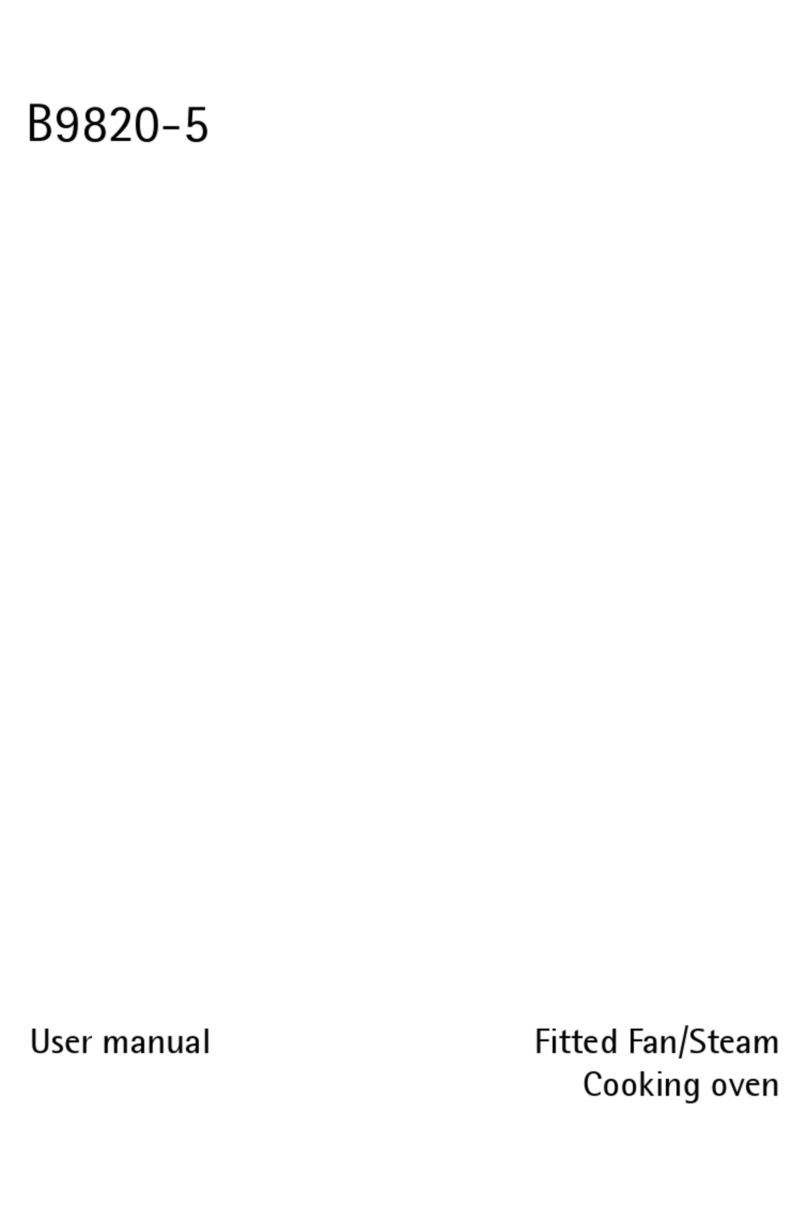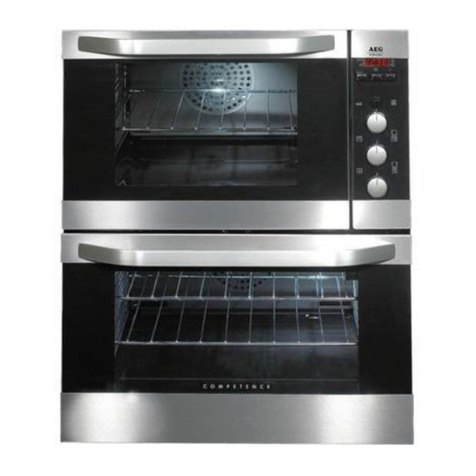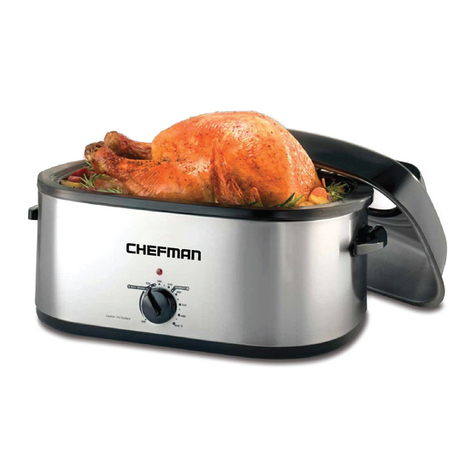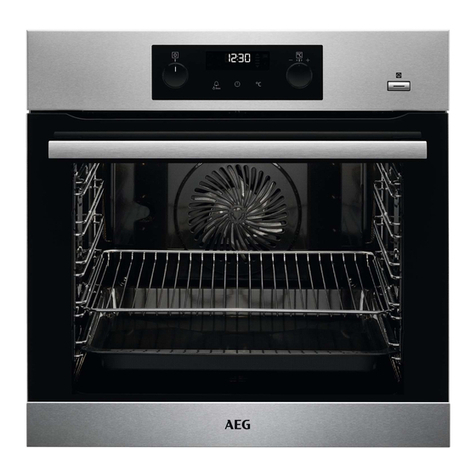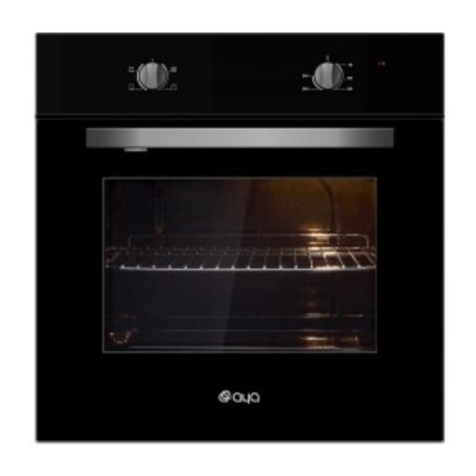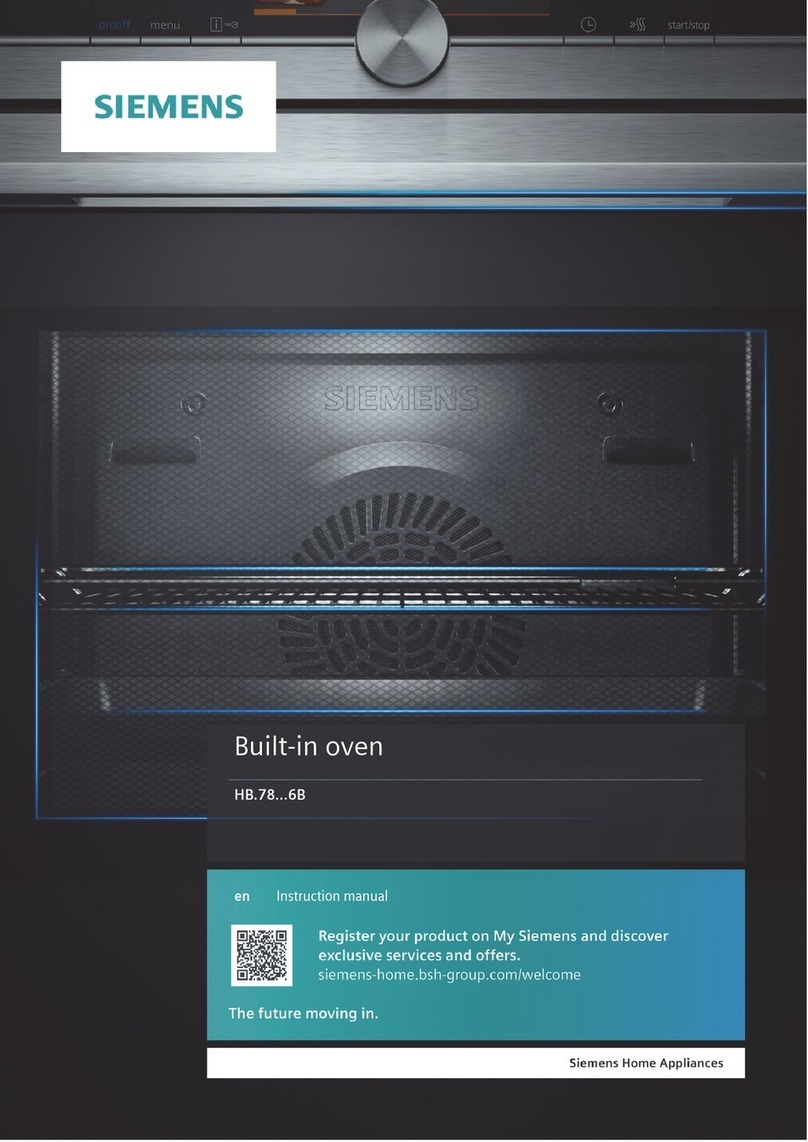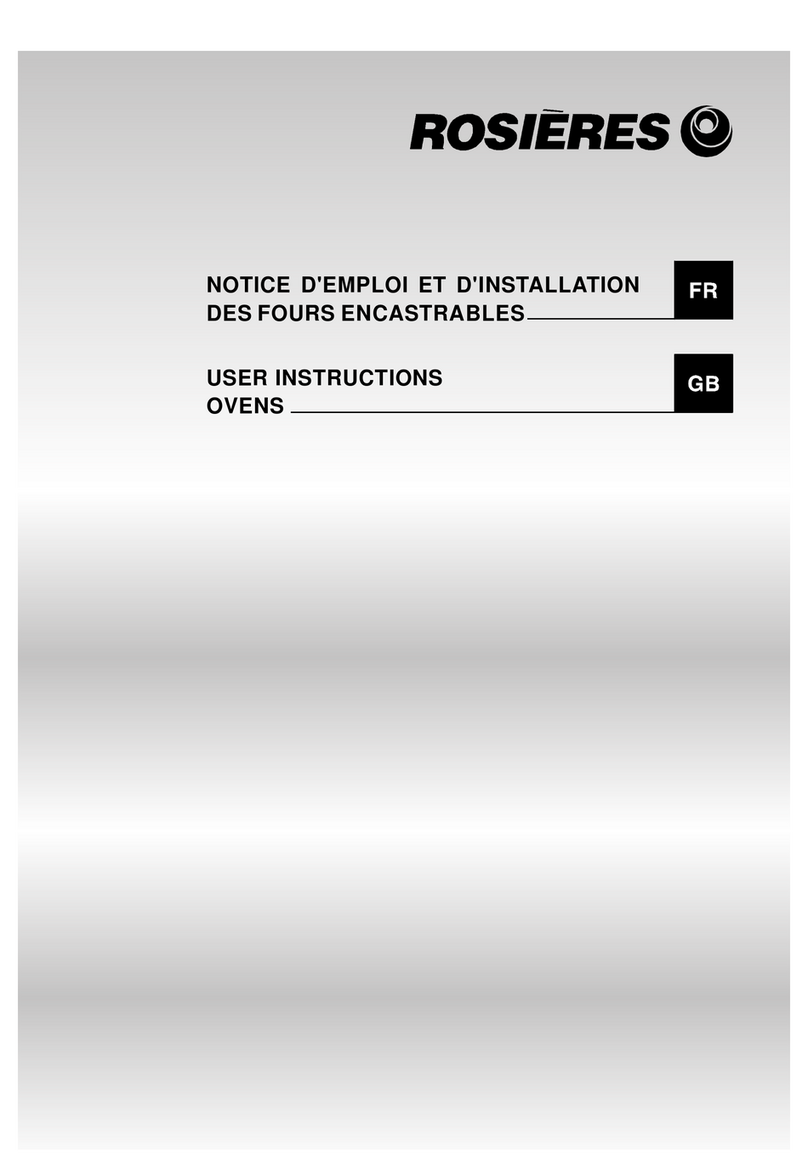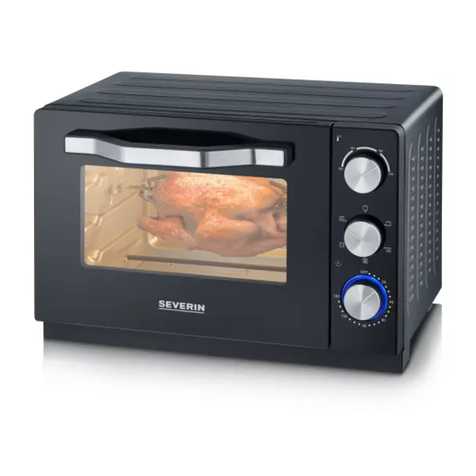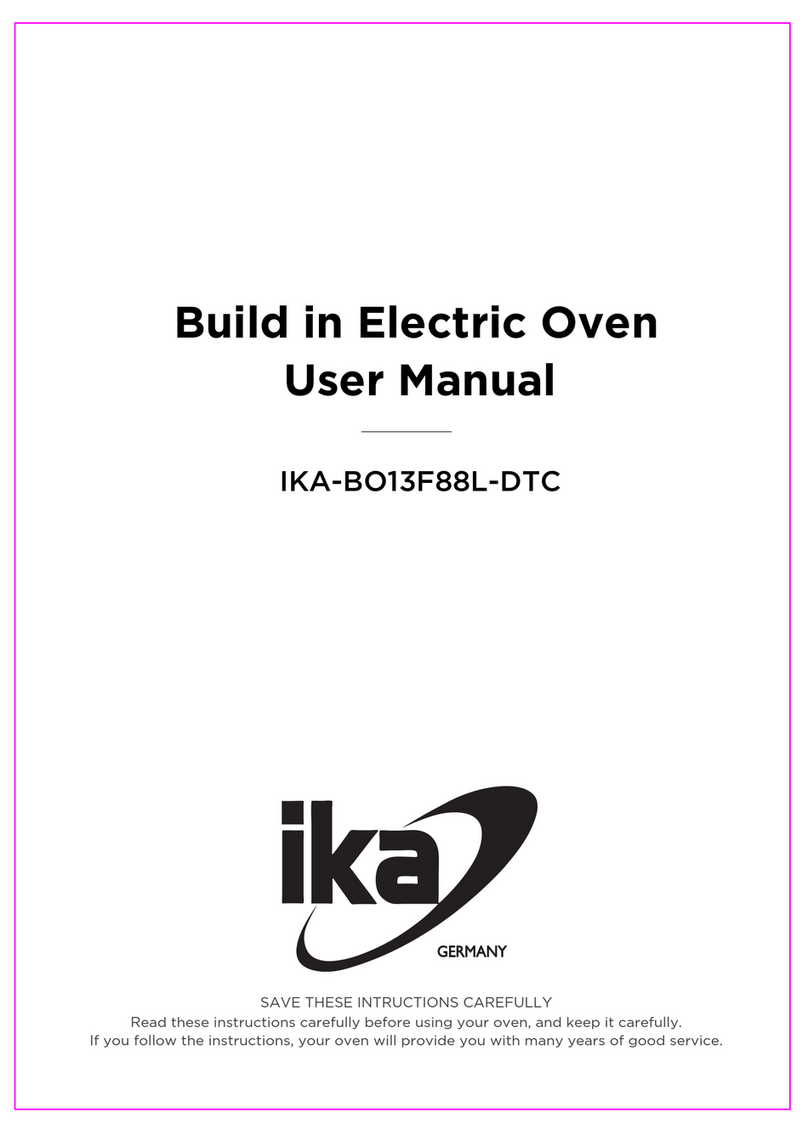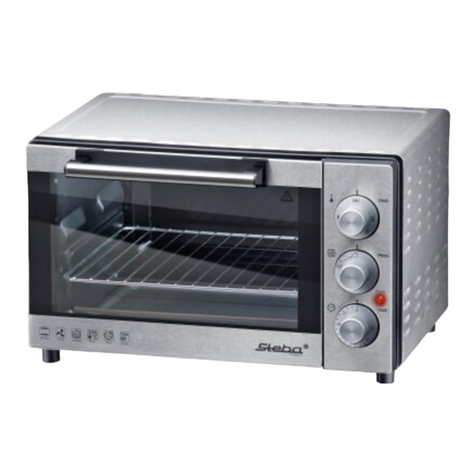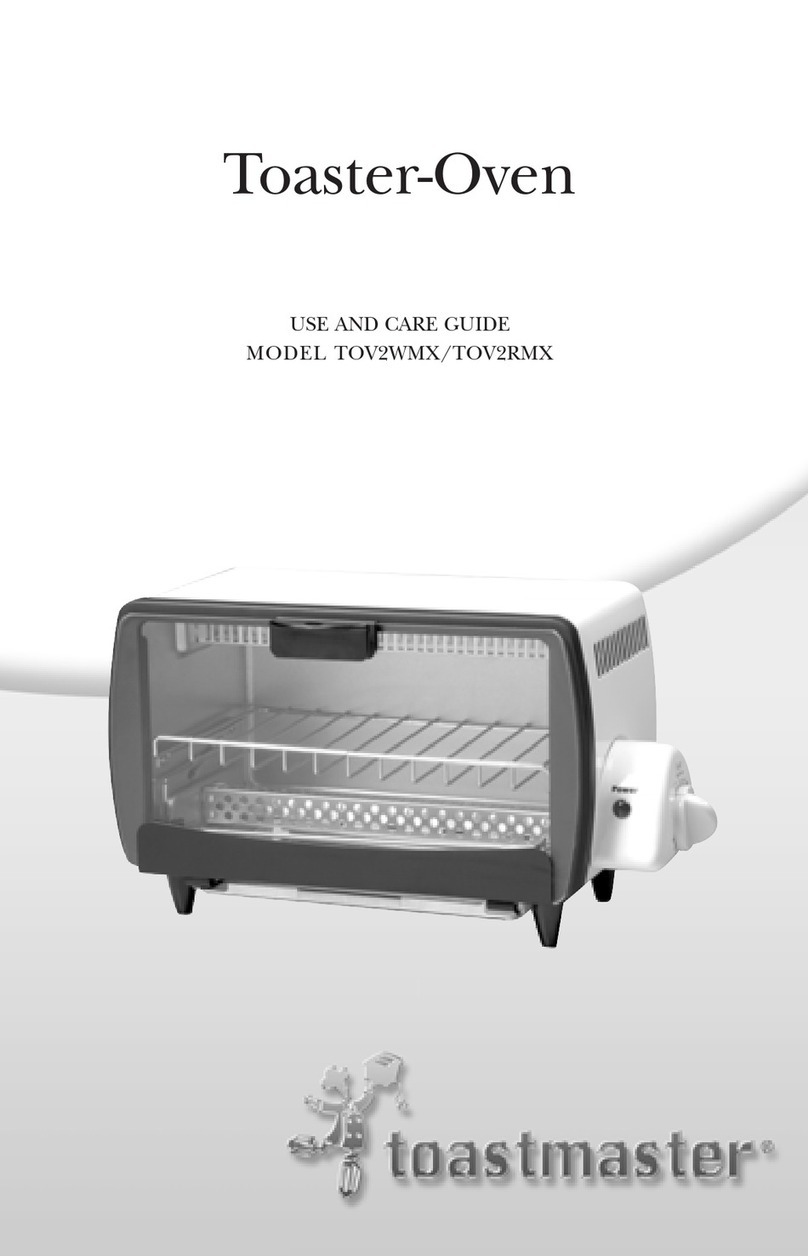Roper B9758B0 User manual

I
EL=ECTRleC BUILT-IN DOUBLE OVEN
USE ANb CARE MANUAL
1 Copy Your Model and Serial Numbers ‘i
_- IN THE BOX BELO:
Model and Serial numbers are on a
plate, behind the oven door, on the
front frame. If you call for service, or
with a question, have this information
ready.
Keep this book, your installation guide,
your warranty and the sales slip
toget her.
Model No.:
Part No. 338973

SAFETY RULES . . . .
HOW TO USE YOUR OVEN
l Clock and Oven Controls
l Oven Light
l Oven Vent
l New Oven Odor
l Preheattng
COOKING HINTS . . . . .
l Rack and Pan Arrangement
l Using Fotl
l Broiling Tips
l Postionrng Broiler Pan
l Choosing Oven Cookware
l Common Bakrng Problems
and Causes ,-
. .
. . .
. . .
.
394
. . . . .
5-7
5.6
7
7
7
7
. . . .
8-10
.8
8
9
9
10
10
CLEANING AND CARE .........
.
11-15
l Oven Cleaning .................. 11,12
. Cleaning Chart .................. 13
l Removable Oven Doors ............ -14
. Removable Oven Racks ............ 15
. Replacing the Oven Light .......... 16
l Removable Oven Control Knob ...... 16
. Adjusting Oven Temperature ........ 17
PREVENTING SERVICE CALLS ....... .18

IMPORTANT INSTRUCTIONS
Read the Safety Rules below and all operating instructions
before using this appliance.
Keep this manual for later use.
Be sure your oven is Installed and grounded
properly.
Never try to frx or replace any part of the oven
unless this book tells you to. All other work should
be done by a skilled technician.
Never block free airflow through the oven vent.
See page 7.
Teach your children not to pla; with oven knobs
or any other part of the range. Never let children
sit or stand on the open oven door.
Never leave children alone or unwatched where
an oven is in use. Children should never be allow-
ed to sit or stand on the open oven door.
Teach chrldren not to play with oven controls.
Never use your oven for warming or heating a
room. Such use can be dangerous and hurt oven
parts.
Y
Never heat unopened food containers. Pressure z
build-up may make container burst and cause z
injury. u)
Never wear loose clothing while using your oven.
Such clothes could catch fire.
Always use care when opening oven door. Let
hot air or steam out before moving food.
Always move oven racks whrle oven is cool.
Always use dry pot holders when removing pans
from the oven. Moist or damp pot holders can
cause steam burns. Do not use a towel or other
bulky cloth. It may catch fire on the element.
Never try to move a pan of hot fat, especially a
deep fat fryer. Wait untrl the fat has cooled.
Always keep the oven area clear and free from
things that will burn, gasoline and other flam-
mable vapors and liquids. Never store things in
an oven. These things may catch fire and plastic
items may melt and burn.
3

Never touch oven heat/no elements or tnterror sur-
faces of oven, Heating elements and nearby areas
may be hot enough to burn you even though they
are dark in color. During and after use, do not let
clothing or flammable materials touch heating
elements or oven surfaces until they have had time
to cool. Other surfaces that may’become hot dur-
rng use are the oven vent duct and the oven door.
When brotling, always take the broiler pan out of
the range and clean it when you are finished cook-
ing. If you forget that a broiler pan was left in the
range and later turn on the oven, you may start
a fire.
Never use aluminum foil tdline oven bottoms. On-
ly use foil as shown on page 8 of this book. Im-
proper use of foil could start a fire.
SELF-CLEANING OVEN ONLY
Always take the oven racks, the broiler pan and
other pots and pans out of the
oven
before a self
clean cycle.
Never use any kind of oven cleaner or oven liner
coattng. Do not use any spray cans near your
oven. The gas used to make these cans spray can
make metal parts rust in areas of high heat.
The door gasket is needed for a good seal so care
should be taken not to rub or move the gasket.
Clean with hydrogen peroxide. See page 11.
Always follow cleaning instructions on pages 11
and 12 of this book. Never try to clean other things .
in the oven during a self clean cycle unless this
book tells you to.
4

CLOCK AND OVEN CONTROLS .- UPPER OVEN
TO SET THE CLOCK
1. Push BAKE button
2. Turn SET knob until desired temperature ISdlsplayed. The oven begins
to heat wlthln two seconds, and the display ~111show the temperature
as it rises (In 5oF steps).
3. The Notilicatton Tone will sound when the oven has stabilized at the
selected temperature. The display WIIIshow this temperature before
the lone.
4. When finished baking, push the OVEN CANCEL button.
Note: To recall what temperature you have selected while the risng
temperature is being shown, push and hold the BAKE button. The selected
temperature will be shown while you hold the BAKE button and will return
to actual oven temperature when you release the BAKE button. You can
change the selected temperature at anv time by pushing the BAKE but.
ton and turning the SET knob.
1. Push the CLOCK button.
2. Turn SET knob to correct time of day. Clock is now set.
Note: To display the lime of day during tlmed baking, push the CLOCK
button. Thus
will
show the time but will not cancel any oven operation.
TO SET THE TIMER:
--
1. Push TIMER button.
2. Turn SET knob to desired amount 01time. The Timer WIIIimmediately
begin lo count down.
3. When time is up, the end 01cycle tone will sound.
4. To cancel the Timer, push and hold TIMER button for lhree seconds.
This WIIIclear the TIMER function. If ‘ye “Timer time” was being
displayed, the display will go to the tlr: e of day. If the “Timer time”
was not being displayed, the display will not change.
Note: The Timer is a reminder only and will not operate the oven. You
can use the Timer whether or not the oven is being used. The Timer does
not interfere with oven operations.
TO BROIL:
1. Push BROIL button.
2. Turn SET knob until HI or LO Broil
IS
visible In the display (see page 9).
3. When flnished broiling. push the OVEN CANCEL button. .

TO USE T!MED OVEN/DELAY START
Put the load in the oven and program your Electronic flange Control lo
turn the oven on and off Follow lnstructlons below
CAUTION
Never let loo&s’lt for more than 4 hours before cookmg starts.
when you sel’*our oven for a delay slat-t. Room temperalure
ISIdeal for tha @rowth of harmful bacteria. Be sure &en light
growth.
Note: To cancel any timed oven operation. push lhe CANCEL bulton.
TO START NOW AND STOP LATER:
1. Push COOK TIME button.
2 Set length of baking time with SET-knob.
3. Push BAKE button
4. Set desired temperature with SET button.
5. When COOK TlME is reached, the end of cycle tone
will
sound and
Ihe oven
WIII
turn OH
TO START LATER AND STOP LATER:
1. Push COOK TIME button -
2. Set lenglh of bakmg time with SET knob
3. Push STOP TIME button
4 Set time of da)Fwhen baktng should be completed with SET knob
5 Push BAKE button
6. Set desired temperature with SET knob.
7. When STOP TIME
IS
reached, the end of cycle tone WIIIsound and
the oven WIIIturn OH.
Note: You can push the STOP’TIME button to find out when Ihe oven
WIIIturn off Push and hold the COOK TIME button to find but when the
oven wrll turn on.
When a function has been entered, you can recall what has been pro-
grammed by pushing the corresponding function button. The messages
in the display show you which Iunction IScurrently being dlsplayed. While
the function ISdisplayed. you can change It with the SET knob You can
change any programmed function at any time
Never slide the door IocWunlock handle Into the LOCK posltton while try-
ing to bake or broil. You ~111not be able to program your oven to bake
or brotl 11the oven door
IS
locked. If you try to lock the door while the oven
IS
on, the oven
will
turn OHlmmedlately
LOWER OVEN
The lower oven ISoperated through the Lower Oven control located on
the left side of the control panel. You can use the lower oven while the
upper oven IS being used. You cannot broil In the lower oven
TO BAKE:
1 Turn Lower Oven Control to desired temperature.
2. When fInIshed turn Lower Oven Control to OFF.
LOWER OVEN SIGNAL LIGHT
The oven slgnal light WIIIglow when the Lower Oven control ISturned on
and the oven IS heating. When the set temperature
IS
reached, the light
will go out and then cycle on and off to show the temperature IS being
maintained.
6

TONES OVEN LIGHT
End of Cycle Tone (3 long beeps one second on, one second oft) shows
that a trmed oven operatton has reached STOP TIME or that the Trmer
has counled down -I
Attenhon Tone (series of short beeps. one quarter second on. one quarter
second off. untrl proper response IS grven) WIIIsound rf oven has only
been panrally programmed. Fox example, If you have selec:% a COOK
TIME but no temperature. you wrll hear the attentron tone untrl you select
a temperature or push OVEN CANCEL.
Notification Tone (srngle. one second beep): shows that the oven has
stabrlrzed at the selected temperature.
Keytone (single. one fenlh second beep). sounds when any button IS
pushed.
Failure Tone (series of very rapid beeps. one&ghth second on, one quarter
second off) drsplay WIIIshow FO-F6. Cancel latlure tone by pushrng the
OVEN CANCEL button. If the farlure occured while you were programm-
ing the Electnc Range Control. push the OVEN CANCEL button and try
again. If you still get a failure tone that does not stop after 16 seconds,
call for servrce. II you are unable to cancel the tarlure tone wtth the OVEN
CANCEL button, unplug the range or disconnect the crrcurt breaker.
If you prefer that your range not have an a’. I!ble tone at the end of a cycle
or when you push a button (Key Tone), you can eliminate the End of Cy-
cle and Key Tone by pushing and holding the OVEN CANCEL button un-
til you hear a short beep (In approxrmately two seconds). If you wash to
activate the tones again. push and hold the OVEN CANCEL button once
more untrl you hear a short beep Cancelling or aclrvatrng the tones should
only be done when there ISno oven operation programmed. Pushrng the
OVEN CANCEL button wtll clear all functrons except Ihe clock and Trmer
The oven lrght switch is located on the left srde of the control panel. See
page 16 for more Informalron. s
OVEN VENT
When the oven ISon, heated air moves through a vent below the control
panel. C
The vent area could get hot dunng oven use. g
The vent is needed for proper air flow in the oven and good baking
results. Do not block this vent. Doing so may cause cooking failure, fire d
or damage lo the oven. 5
NEW OVEN ODOR
0
Dunng the frrst bakrng and broiling cycles of your new oven, there may
be some odor. This is normal and IScaused by the heatrng of new parts s
and insulation The odor will go away within a short trme. A vent fan or 3
other ventilatron will help to clear the way.
PREHEATING
Preheating lets the oven heat evenly before the food IS put In. Allow 10
minutes at temperature less than 35OOF and about 15 mrnutes at
temperatures of 35OOF or more.
With recipes that call lor an oven preheated to a certain temperature. It
ISvery Important that you follow those rnstrucbons. It ISnot lkkely that you
will gel good baking results every time wrthout preheating to the needed
temperature unless the rectpe says to start In a cold oven.
After the oven IS preheated and you are ready to put the food in, try to
have everything handy so that you will not have to leave the oven door
open for an extended period of trme.
Opening the door to check the food during baking makes rt rmposstble
for the oven to stay at the temperature you have selected. Try to trme your
bakmg and check only when close to berng frntshed. .
NOTE: When using cookware made of ovenproof glass or PJery, Teflon
coaled cookware or dull or darkened pans in the oven, be sure to reduce
, recipe temperature by 25OF (see Choosing Cookware Chart, page 10).

RACK AND PAN ARRANGEMENT USING FOIL
Put oven rack(s) In
place
before lurnrng on Ihe oven. Rack posrtrons ar:
numbered 1
lo
4. startrng at the bottom wrth number 1. In
general,
when
uvng only one rack, postron No. 2 should be used. When usrng two racks,
posrtrons No. 2 and No 4 work best.
For Baking
When usrng cookre sheets, place fhem with the long srde loward the front
01Ihe oven and centered on the rack When usrng Iwo cookre sheets at
the same time use rack posrtrons No 2 and 4 The cook es on the lower
rack may be done l-2 mrnutes before the ones on the gher rack You
may want IO swrlch rack posrtrons when bakrng IS hallway Irnrshed.
To catch spillovers, cuf a prece of loll slrghlly larger than the pan and turn
up the edges use two oven racks and put the loll on the lower oven rack
below Ihe pan Do not use alumrnum (011drrectly under a pan on the same
oven rack The forI WIIInot reflect heal away from the pan
Pans too close to each other. to oven walls or lo the oven bottom block
lhe lree movement of arr Improper arr movement causes uneven brown.
rng and cookrng
A
Do not cover the oven bottom or an entrre oven rack wrth
1011.The fool can block normal heat flow, cause cookrng
farlures. and damage Ihe oven rnlenor.
Normally there should be 1% to 2 Inches of air soace on all srdes of each
pan In the oven See 11~sbelow
For Roasting
For slow browning, place a fool“lent” loosely over the meat. ThusISespecral-
ly good on a large turkey. The “tent” lets oven heat circulate under the
foil Sealrng the loll
WIII
tend to steam the meat.
To reduce spattering, lrghtfy crush forI and put It In the bottom of the pan
under the food
Sheer Cakes, Cooktes. Angel Food
BISCUIS
or Sponge Cake
The pan or pans using the least
amount of rack area should be When usrng two racks and
several pans, stagger them so
@at:~I on lhe lower of the Iwo no 1an IS directly above
3not er
,
Cake Layers. Pies
Casseroles, 3 pans Cake Layers, Pies
4
Pans (staggered)
For Broiling
A
Do not cover the entire broiler grid with forl. Poor
drainage of hot fat may cause a broiler fire.
If a fire starts. close the oven door and turn controls
off. If fire contrnues. throw baking
soda
on the fire. Do
not put water or flour on the fire. Flour may be explosrve.
1
I
I

BROILING-TIPS
. Your oven door should be open lo the slop position while broiling
(See page 14). II the door ISclosed, the food wrll roast and not broil
.
l
Use only the brorler pan and gnd lurnrshed wrlh your range lor brorl-
rng They are desrgnedlor proper drarnage 01fat and lrqurds and help
prevent spatter. smoke or fire
l
Do not preheat when brorlrng. For even brorlrng on both srdes start
the lood on a cold pan Allow slrghrly more lhan hall the cookrng lrme
for Ihe lrrst srde lhen turn the food usrng longs. If you prerce the meal
wrth a fork, Ihe furces WIIIescape. .
l
When broilrng frozen meats, use one rack posrtron lower than recom-
mended up lo 1% trmes the suggested brorlrng time
Most foods can be brorled on the HI settrng Select Ihe LO brorl senrng
to avord excessive browning or dr
Ihe well done stage (such as thrc pork chops or poultry)
tl1ng01loods ihal should be cooked to
The closer the lood ISlo the br.orl element the fasfer the meal browns on 0
lhe oulsrde yet stays red lo punk rn Ine cenler Moving the meal lanher
away
from the element lels lhe meat cook lo the center whrle browning E
outsde 3
Rack 1
Food . Posrtron Total Trmes
4 = Hrghesl (Mrnutes)
1 = Lowest
l
Tnm Ihe outer layer of laf lrom sleaks and chops. Skt lhe latty edges
to keep the meat lrom curlrng.
Steak ’ Thrck
Rare
Medrum
Well Done
l
Always pul the lood berng brorled on the proper rack (see chart al right)
Food placed too close lo the broiler may spalter. smoke or calch fire.
l
For maxrmum furcrness. sall the frrst side fust belore turnrng the meal.
Salt the second side JUSIbelore serving.
Ground Beef Padres
Medium 1” Thrck
Medrum ‘12” Thtck
l
Brush chicken and fish with butter several times as they broil. When
brorlrng lrsh. grease the gnd to prevent stickrng and broil with skin srde
down. It IS not necessary to turn fish. -
L
l
Never leave a soiled broiler pan in the range. Grease rn the pan may
smoke or Ignite the next time oven in used. See page 13 lor trps on
cleanrng the brorler pan and gnd.
Lamb Chops 1 Thrck
Pork Chops 1” Thick
Pork Chops l/z” Thick
Ham Slrce ‘12” Thrck
Fish (Fillets)
Chicken (Ptec:r?s)
Franklurlers
POSITIONING BROILER PAN (upper oven only)
Bacon
Brorlrng IScookrng by drrect heal lrom the upper oven element Tender
cuts of meat or mannaled meat should be selected for brorlrng For best
results sfeaks and chops should be al least IC“ thrck
After placrng food on the brorler pan, put lhe-pan on an oven rack In Ihe
roper postron The recommended rack posrtron and cookrng trme can
L found rn the chart at right.
This chart is a general guide. The size, weight, thickness
and starting temperature of the food, as well as your own
personal preference. will affect the cook time.
4 9-1 1
3 1315 _
3 2 l-23
3 16 16
‘4
7-Q
3 1621
3 27-29
3 I 16-18
3 1l-12
3 11-13
2
45-55
3 6-l I
3 9-l 1
9

IOVEN COOKWARE I 1
I
I I
Alumrnum Absorbs heal faster than glass or steel and conducts heal well. Produces delicate brownmg, lender crust, and
reduces spallerlng of roasls. Best for cakes, muffIns, quick breads, cookies, and roasllng. I
I
Ovenproof Glass/ Because IhIs cookware absorbs heat quickly and holds it-well. you should lower your oven temperature
25OF. Gives
Pollen/ food a deep, crusty brown lop. Best for casseroles.
Teflon. Dull or
Darkened Cookware ’ Absorbs heal quicker than shiny cookware. Lower your oven temperature 25OF (except’ for paslry). Good for pies
and other foods baked In pastry shells.
COMMON BAKING PROBLEMS AND CAUSES
CAKE RISES UNEVENLY
l
Range or oven rack nof level
l
Pan warped
l
Baiter spread unevenly In pan
l
Pans 100 close lo oven wall or rack too crowded
-
CAKE HIGH IN MIDDLE
l
Too much flour
l
Oven temperature loo high
CAKE NOT DONE IN CENTER
l
Wrong s12e pan
l
Oven loo hol
l
Pan no! centered In oven
v) CAKE FALLS
2
l
Too much shortenrng, llquld or suga!
l
Temperature loo low
I
l
Pan 100 small
l
Oven door opened too often
l
Too much leavening or stale leavening
l
Overmlxlng aHer addlng flour
BOTTOM PIE CRUST SOGGY
l
Fllkng too JUICY
l
Fllllng allowed lo stand In pie shell belore baking
l
Used shiny pans
l
Temperature loo low at start 01 baking
l
Crust and/or fllllng not allowed to cool before Hllng crust
BURNING AROUND EDGES OF PIE CRUST
l
Oven temperatures too high
l
Edges of crust loo thin or loo high
l
Oven loo full or pans loo close together
COOKIES AND BISCUITS BURN ON BOTTOM
l
Oven preheat time too short
l
Pan 100 deep or loo large
l
Used dark pans
l
Used Incorrect rack posrtlon
FOOD NOT DONE AT END OF COOKING TIME
l
Oven temperature set loo low
l
Oven loo crowded
l
Oven door opened too often
l
Aluminum foil blocklng air movement
10

THE SELF-CLEAN CYCLE
(upper oven only)
1 iiernove Ihe Oro~lpan and ;;rid oven r.achS all ulenslis and any 1011
rhaf may be in rhe oven If oven racks are lefl In Ihe range duftng a
clean cycle they WIIIdarken ose Iherr lrrsler and become nard 10slrde
2 5011on Ihe oven Iron1 lrame under fhe front edge of the cookloo the
door tlner ourside Ihedoor seal and Ihe Iron1 edqe 01the oven cavlly
(dbOuf I tnfo Ihe oven) WIIIno1be cleaned aurntng a clean cycle (see
llluslrallcn below) Clean these areas by hand oelore slartlng a Clear1
cycle
Jse detergent and hot water wrlh a soap-IrIled sleel wool pad, then
<Inse well wllh a vrnegar and waler mxfure Thrs wtlr help -‘event a
brown resdue lrom lormlng when rhe oven IS healed
Before
A Clean Cycle
3 Wipe up heavy splllovers on Ihe oven bonom Too much so11may cause
smoking During the clean cycle
4 Clean lhe door seal by usrng a clean sponge to soak Ihe soried area
wrth hydrogen peroxIde Repealed soakrng may be needed Uepen-
ding on the amounl of SOI/ Frequenf cleanrng wtll prevenf excessive
so11build up Do nol rub rhe door seal excessvely The llberglass
malehal 01Ihe seal has w, extremely low resistance lo abrasion Any
cotton material especally (includrng cottonballs). can easel
rnto the seal Do not use any collon materrals lo clean I
L rub a hole
e seal An
intact and well lrnrng oven door sea IS essenlral lor energy
etircrenl Oven operatron and good baking results II you nolrce the seal
becomrng worn frayed or damaged In any way or 11II has become
drsolaced on lhe door you should reolace the seal
mow,mAML
DO NOT use commercral oven cleaners or oven oroleclors rn or near Ihe
oven These products plus the htgh lremperalure of Ihe clean cycle may
damage the porcelatn flnrsh
DO NOT clean glass ceramic cookware or any other cookware In the oven
during a sell-clean cycle
IMPORTANT INFORMATION
All controls must be set correclly for fhe clean cycle lo work properly To
help you understand how Ihe clean cycle works the slages 01Ihe cycle
are noted below
1. The controls are set.
2. The word CLEAN Wattbe on In the display, the oven begrns to heat
and the door locks automattcally.
3. For your safety the oven door can not be opened (the word LOCK
wrtl be on In the Electrontc Range Control display )
4. When the 3% hour clean cycle ISover the word CLEAN WIIIbe oil
In the drsplay the oven beglns to cool.
5. When the temperature has fallen below lockrng temperature the door
can be opened (the word LOCK will be OHrn the drsplay).
After a clealng cycle, the oven door cannot be unlocked unless:
The temperature has had trme to drop lo a safe levd and the
word LOCK is OHin the Electronic Flange Control drsptay.
c
11

TO SET A CLEAN CYCLE TO STOP A CLEAN CYCLE:
The sellcleantng cycle IS preprogrammed lor 3% hours. You can also
set the electronic ranqe control lor a delayed slarl of the clean cycle
To self-clean:
1. Push the CLEAN button.
2. Turn SET knob tn the clcxkwlse drrectlon about % turn.
The word CLEAN WIIIbe on In the display.
NOTE: You can find out when the clean cycle WIIIbe finsihed by
pushing the STOP TIME button.
To use delayed self-clean: _-
1. Push STOP TIME button
2. Turn SET knob to time of day when you wish cleaning to be com-
pleted (must be more than 3% hours later than current time of
day).
3. Push the CLEAN button.
4. Turn SET knob in the clockwlse dIrectIon about l/z turn.
The words DELAY CLEAN WIIIb :’ In the display until the clean cycle
starts. After the clean cycle starts e word CLEAN will be on rn the
display.
Note: Dunng a delayed self-clean operation you can find out when the
oven turns on by pushing and holding the CLEAN button.
1. Press the OVEN CANCEL button
2. Wail unlll the oven has cooled below locking temperature and
the word LOCK IS off in the display
You ~111not be able to open the door unless the oven temperature IS al
a sale level If you cannot open the oven door immediately after the
word LOCK goes off, wall about one minute and try agaln.
WHEN A CLEAN CYCLE IS FINISHED
1. When a clean cycle IS flnlshed the word CLEAN WIIIbe off in the
display.
2 Walt untrl the oven has cooled below locking temperature and
the word LOCK
IS
off in the display.
You WIIInot be able to open the door unless the oven temperature IS at
a sale level. If you cannot open the oven door irnmedtately after the
word LOCK goes off, wall about one minute and try again.
AFTER A CLEAN CYCLE
After a clean cycle, you may notice some white ash in the oven Just
wipe
It up with a damp cloth.
If white spots remain. remove them with a soap-Illled steel wool pad. Be
sure to rinse thoroughly with a vinegar and water mixture. These
deposits are usually a salt residue that can not be removed by the
clean cycle.
II the oven IS not clean after one clean cycle, the cycle may be
repeated.
12

PART- - CLEANING INSTRUCTIONS
Control Panel Wash control panel with soap and waler Do not use
abrasrve cleaners.
Oulsrde Frnrshes:
Chrome
Glass
(some doors)
Pam1
(some doors)
Oven Finishes:
Porcelain
(lower oven)
Wash with soap and waler. A chrome cleaner may be
used
Wash with a soapy damp cloth Remove stubborn so11
with a paste of baking sod 3 and waler or ammonra and
water. Do not use abras. z naterrals. Before using an
all-purpose cleaner, check Ihe label lo be sure II is
recommended for glass-some will
Wash with soap and waler, rinse then dry with a paper
towel Avoid cleanrng powders or abrasives which may
Wash with soap, waler and a scouring pad. Soak stub-
born stains with an ammonia soaked paper towel, or set
a dash of ammonia water In the oven overnight to loosen
~4, then rub with a scouring pad. Rinse thoroughly. When
using oven cleaners, follow package directIons and be
sure that no traces of the oven cleaner remains in the
permanently damage glass. To help prevenr a brown
- residue lrom formlng on the oven wlndow the next lime
the oven
IS
heated. rinse the lnsde of the wlndow wtlh
vinegar and water, lhen dry
scratch the surface.
oven. Traces of the cleaner could put statns on the frnrsh
when heated. To make sure this does not happen give
a final rinse of vinegar and waler. Caution: Do not coal
heatin a element and thermostat bulb
oven). ever use oven cleaner on outs1
din upper part of
aluminum. chrome or baked enamel. e oven surfaces,
Self-Cleaning
(upper oven)
Oven Door Seal
(self-cleaning ovens)
Use soap, water and a scounng pad for touch up clean.
1ng between self-cleaning cycles and rinse thoroughly
Soak sorted area with hydrogen peroxide (see page 11).
Avoid any contact with the oven door seal (see below).
Avoid all oven cleaners.
Oven Racks Remove from oven (see instructions on page 15) and
wash at sink with soap, water and a scouring pad. If oven racks are IeH in oven during a clean cycle, wipe edges
with vegetable 011so they slide In and out easier.
Brorler Pan and Grid DO nc. :eave in oven lo cool. If you soak immediately,
cleamup WIII be easer. Remove pan from oven and
remove fat and drippings. Sprinkle pan with detergent
then cover wllh a wet cloth or paper towel and let soak.
Later wash In soap and waler using a scouring pad as
necessary. Both the pan and god are drshwasher safe.
~I
13

REMOVABLE OVEN DOOR(S)
(models wlthout removable rack guides)
The oven door can be removed lor cleaning
To remove:
1 Open Ihe door to Ihe slop poslion (see ~llusrral~on)
7 Grasp the door al each sde and llfl up and OHthe hinges
See the cleaning chart on page 13
NOTE: When the door IS removed and hinge arms are at slop poslhon,
do no1 bump or try IO move the hinge arms. The hm-,s could snap back
causing an mjury lo the hands or damage IO the po~celam on the front
of Ihe range. Cover the hinges wrth loweling or empty towel rolls while
workmg In the oven area.
To replace:
1 Hold the door over Ihe hinges with the slots al the bottom edge of
-
the door lined up with the hinges The hmge arms must shll be In
the stop postion.
STOP
POSITION
2. Slide the door down onto the hinges as far as II will go and close
the door.
REMOVABLE OVEN DOOf%
(models with removable rack guides)
The oven doors can be removed for cleaning
2 To remove:
ii
7
Open
Ihe door lo the
brad
stop poslfton and grasp the door at each
side (see Illustration)
2
u Lift the door up a bit, then pull straight toward you.
To replace:
: 1 Make sure that hinge arms ; c’ In posItIon 0 (broil stop posItIon).
F Note: II a hmge arm snaps into posltion A, it musl be moved back lo
posllion B before the door can be replaced.
II
f
2. Carefully Insert the hinge arms through the openings II- the front frame
and push the door Into place while holding the door up
2 3 When lhe bottom edge of the door IS flush against the front frame,
9 allow the door to senle Into place 14

REMOVABLE OVEN RACKS AND GUIDES
(some models)
Be sure not lo scratch Ihe oven fmlsh when mslallmg or removing oven
racks.
To mslall:
1 Pur tne pegs on the end of !he rack g&e Into the holes in the oven
back
2
Lock [he Iront hook In the slot in the oven side ,
3 Se1 Ihe raised back edge of Ihe oven rack on a pair of rack guides
so the hooks al the sides of the rack run underneath rhe rack guides
4 Push the rack In until you reach rhe bump in Ihe rack, then Ml the front
01 Ihe rack a btr and push Ihe rack all the way In
To remove:
1 Pull the oven rack out. then up, In one motion
2 Llh lhe front of the rack guide to unhook IIfrom the oven wall and pull
OUI
See the cleaning lnstructlons on page 13
RACK HOOK RACK
BUMP 15
REMOVABLE OVEN RACKS (some models) 0
Be careful nol lo scratch the oven fmlsh when mstallmg or removing
the oven rack. F
al
To install: z
1 Se! the raised back edge of the rack on a pair of rack guides si-
2 Push the rack In unlll you reach Ihe bump in the rack gulde.~!hen llh e
the lront of the rack a bit and push the rack all the way In 0)
To Remove:
1 Pull the o;en rack out, then up 2
See the cleaning chart on page 13 0
P,
s’

REPLACING THE OVEN LIGHT (Some Models)
Do not touch oven bulb when hot. with wet hands, or wrpe oven lrghl area
v&h wet cloth. Unplug or drsconnect the ekxtrtcal supply lo range before
removrng. -
Never touch the eleclncally live melal collar on Ihe bulb when replac-
ing il.
Electrical power musf be shut off if you have to replace a broken bulb.
UPPER SELF-CLEANING OVENS h
1. Remove Ihe three screws and Ml off the glass retarner. glass cover
and gasket.
2. Replace the bulb wrlh a 40 watt applrance bulb.
3. Replace the gasket. glass cover and glass retarner. Tighten screws
securely.
LOWER NON-SELF-CLEANING OVENS:
Replace bulb with a 40 watt applrance bulb.
GLASS
RETAINER - I
SOCKET ’ . -GASKET
-%b
c-? ,*
-/ ,/ I GLASS
0
COVER
SCREW
,
BULB
SELF-CLEANING OVENS
BULB
SOCKET
_----
b
‘t&#J
i+
u
NON-SELF-CLEANING OVENS
REMOVABLE LOWER OVEN CONTROL KNOB
All control knobs may be removed for easy cleaning by pullrng the knob
L straight off the stem.
See the cleaning chart on page 13.
3 Caution: Read these instructions carefully before replacing the knobs.
Replacing the knobs improperly WIIIdamage the knobs and the spring
0 clip on the stems. If this happens, the knobs will fit loosely.
E To correctly replace knobs:
1.
F
Look at the stem. II has a groove in each side. The groove on one
Me has a spnng ckp. the other groove ISclear (see rllustratron).
.I 2. Check Ihe rnsrde 01 the knob and lrnd the molded nb.
E CLEAR
3. Replace the knob by lrttrng the molded rrb rnsrde the knob Inlo the GROOL” IN VALVE STEM
-9 clear groove on the slem
16

ADJUSTING OVEN TEMPERATURE
The temperature In your new oven has been set correctly al the faclory,
so be sure lo follow the recrpe lemperalures and lames the frrsl lew trmes
you bake In your new oven.
If you lhrnk the oven should be hotter or cooler, you can adlust it yourself.
To decrde how much lo change fhe temperature, set the oven temperature
25OFhrgher or lower than the temperalure In your recrpe. then bake. The
results of thus“lest” should give you an idea of how much the temperature
should be changed
To adjust upper oven temperature:
1.
2.
3.
4.
5.
Push the BAKE bulton.
Select a lemperature between 5OoOF and 55oOF with the SET knob.
Qurckly (wrthrn two seconds, before the BAKE lunctron energizes) push
and hold the BAKE button
The drsplay wrll go blank and then wrll show the amount of degrees
drfference between the orrgrnal factory temperature setting and lhe cur-
rent temperature settrng If the oven temperature has never been ad-
lusted the display
WIII
read 00
The temperature can be adjusted up lo 35OF hotter or 35OF cooler,
In 5OFsteps. A menus srgn (-) before the number means lhal the oven
WIIIbe cooler by displayed amount of i%grees.
When you have made the desrred adtustment, push the CLOCK but-
ton to go back to the time of day drsplay or use your oven as you would
normally.
Note: The self.clean temperature WIIInot be changed by above describ.
ed adjustment.
To adjust lower oven temperature:
1. Turn OVEN TEMP knob to OFF and re--ve the knob by pullrng straght
Off.
2. Look at the back of the knob. The arrow porntrng to the center of the
upper screw lndrcates the orlgrnal factory settrng. The knob can be
adjusted up to 500 hotter or 500 cooler. rn 100 Increments.
3. Use a screwdriver to loosen the two screws about 1 turn each.
Hold the knob handle (A on rlluslralron) while turnrng the knob skrn
(8 on rllustralron) In the destred dlrectron. As you turn you should be c)
able lo hear clicks and feel notches or teeth. Each clrck or notch IS S
100. You can turn up to 5 clrcks or notches In either drrectron.
When you reach the desired adjustment. retrghten both screws.
IMPORTANT: Before you replace the OVEN TEMP knob, carefully 3
read the rnstrucllons for replacing the knob (on page 16). Do not force m
the knob onto the thermostat stem or you may damage it.
n :
MAKES OVEN HOTTER
(Screw Moved Toward Hotter)
MAKES OVEN COOLER
lScrew Moved Toward Cooler) -v
P
17

IF YOU HAVE A PROBLEM
Save tome and money - check this lisl before you call for service.
To ellmmate unnecessary service calls, first read all the lnstructlons In this
manual carefully. Then,
II
you have a problem, always check this ltst of
common problems and possible solutions before you call for service.
If you do have a problem you can not for yoursell. call your authorized
Dealer for help.
ELECTRONIC OVEN CONTROL DOES “!OT WORK
l
Check to be sure oven cord ISplugged Into outlet mpletely. Check
for a blown fuse or tripped circuit breaker.
l
Check for power outage.
l
Check step by step operallng Instructions on pages 5 or 6
l
Check for blown fuse or tripped circuit breaker.
OVEN IS BEEPING
l
See the sectton on tones on page 7.
OVEN DOES NOT WORK -
l
Check to be sure oven cord ISplugged into outlet completely. Check
lor a blown fuse or tnpped circuit breaker.
l
Check for power outage.
l
Is the Lower Oven Control turned on II trymg to use lower oven?
l
Electronic Oven Control not set correctly. See pages 5 and 6.
OVEN GIVES OFF AN ODOR
l
See the section on new oven “?or on page 7
BROILING PROBLEMS
l
Electronic Range Control nol set lo Broil (see pages 5 or 6).
l
Using wrong rack position. See chart on page 9.
l
Aluminum foil not used properly and grease can not drain correclly.
See page 8.
l
You cannot broil in lower oven.
OVEN/BROILER SMOKING
. Broiler pan lull of grease lefi In range from the last time you brolled
food. Dirty broiler pan must not be left In the range or smoking and
a broiler fire can result the next ttme the oven IS used.
l
Aluminum foil not used properly and grease can not drain correctly.
See page 8.
COOKING RESULTS ARE NOT WHAT YOU EXPECTED
l
Are you using a tested recipe from a reliable source? Are you follow-
ing all the instructions In Ihe recipe. such as pan size, preheallng, us-
ing all ingredients called for?
l
Oven too crowded, or using wrong rack position. See pages 8 and
10 lor tips.
. Electronic Oven Control not set correctly. See pages 5 or 6 for step
by step instructions.
l
Using Improper cookware. See tips on page 10.
l
Check the section on baking problems and causes on page 10.
OVEN LIGHT WILL NOT WORK (Some Models)
l
Check for power outage.
l
Check for loose or burned out bulb. See page 16 for replacement
instructions.
l
Check for blown fuse or tripped clrcult breaker.
UPPER OVEN WILL NOT SELF-CLEAN (Some Models)
l
Electronic Oven Controls not set properly. Review step by step In-
instructions on page 12.
l
If oven went lhrough clean cycle but did not get clean, oven was too
dirty and should be cleaned more often. Heavy spllovers were not
wiped
before starting clean cycle. See page 11.
l
Lock handle not in correct posItion. See page 12.
UPPER OVEN DOOR WILL NOT UNLOCK AFTER SELF-
CLEAN CYCLE (Some Models) I
l
The oven has not cooled to the unlocking temperature. The door can
not be opened until Ihe temperature drops lo a safe level. See pages
11 and 12 ..e-
18
This manual suits for next models
1
Table of contents
Other Roper Oven manuals

Roper
Roper Convection Oven User manual
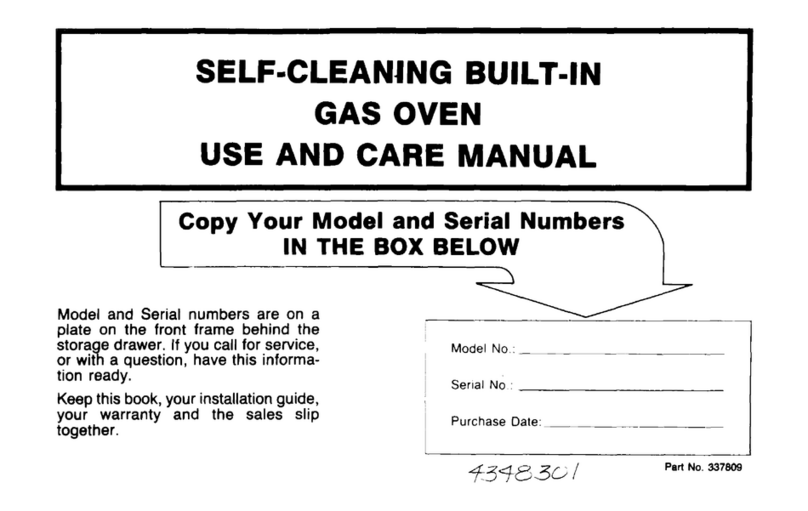
Roper
Roper B8758B0 User manual
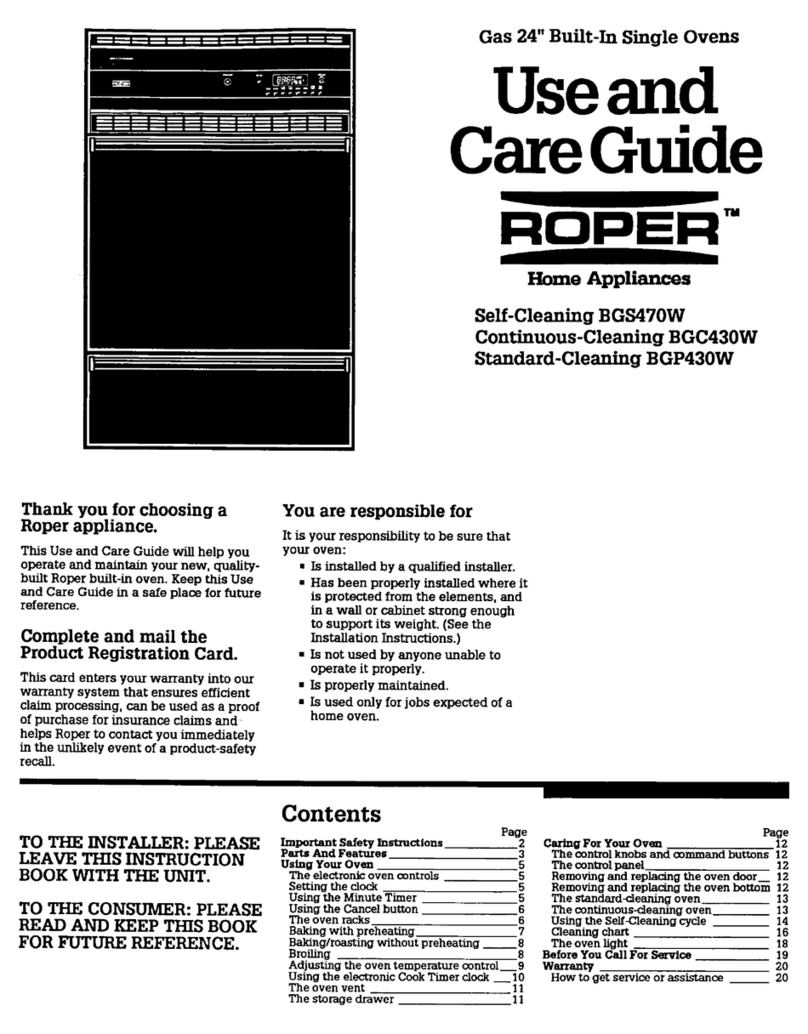
Roper
Roper BGC430W BGP430W User manual
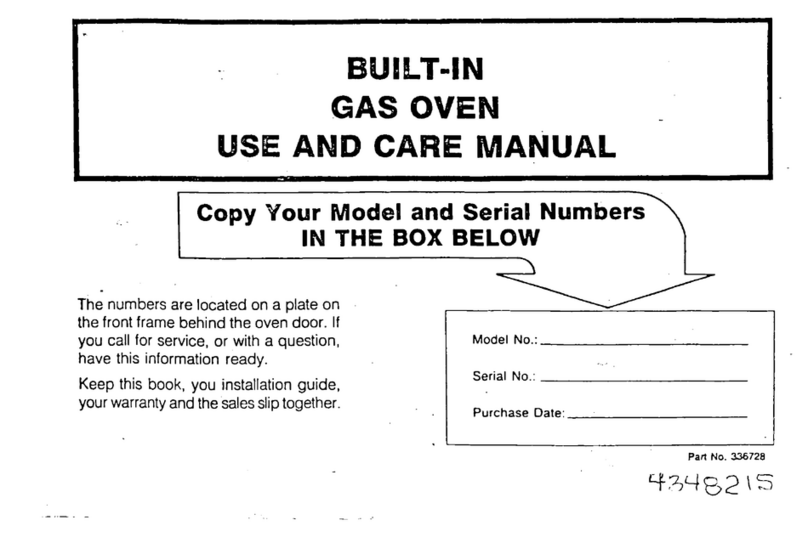
Roper
Roper B4607B0 User manual

Roper
Roper B500 User manual

Roper
Roper Double Oven User manual

Roper
Roper B4007B0 User manual
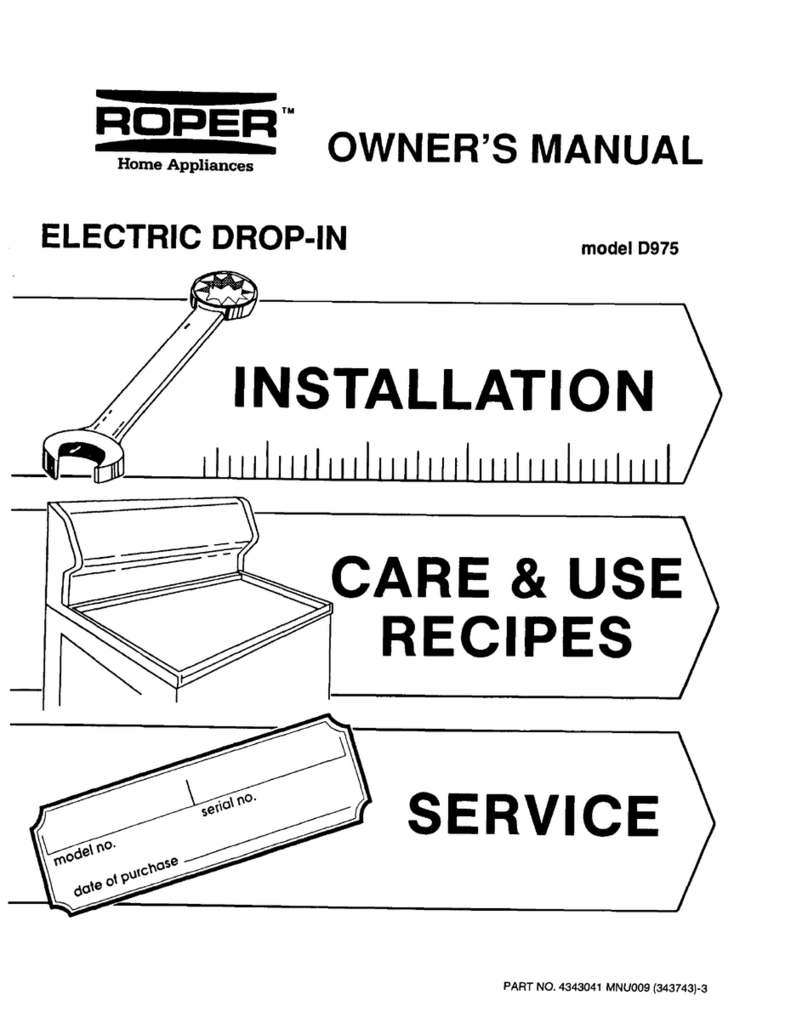
Roper
Roper ELECTRIC DROP-IN D975 User manual
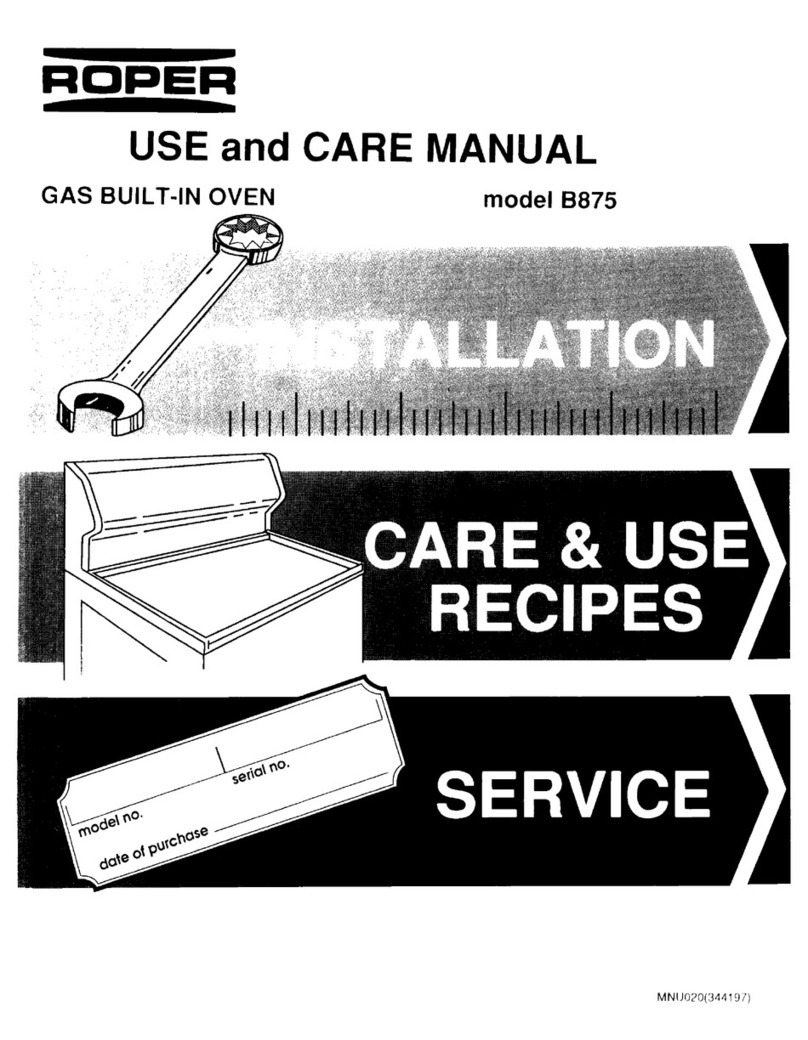
Roper
Roper B875 User manual

Roper
Roper B9907X0 User manual


